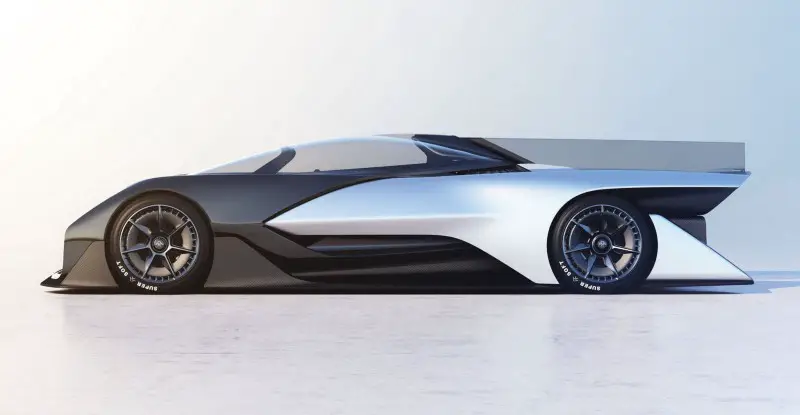Faraday Future FFZERO1
A big part of the idea behind the FFZERO1 electric car is that it has a modular chassis. This make adding more battery cells, or even…

A big part of the idea behind the FFZERO1 electric car is that it has a modular chassis. This make adding more battery cells, or even motors, an easy task. FF went with a four-motor setup, one for each wheel, and a total output of 1,000 horsepower. This is said to be enough to take the car up to 60 mph in 3 seconds.
Similarly, its top speed of “200+ mph” is also theoretical. A bigger car would leave more space for more battery cells, so longer range machines would also be possible. The batteries are all located inside the wheelbase and very low down, so some kind of sports car is also a very real possibility.
The vehicle’s streamlined carbon-fibre exterior is shaped to optimize the way it moves through the air, improving both driving performance and energy efficiency.
A transparent tail fin slotted behind the domed cockpit stretches to the vehicle’s rear. This feature further improves stability when changing direction as well as acting as a digital canvas displaying information such as the battery-charge level, driver name, and track position.
Air flows through the vehicle’s structure thanks to an aerodynamic tunnel, which cools the battery and motor surfaces. Air flowing through the tunnel also reduces air resistance — known as drag — and therefore improves the vehicle’s top speed, which is claimed to be in excess of 200 miles per hour (321.87 kilometers per hour).
Exterior
The FFZERO1 concept looks, simply put, like a race car from a video game set in the future. It’s all fins and ducts and tunnels with LEDs all over. The big glass canopy roof and dorsal fin are reminiscent of current Le Mans prototype racers, and the generous use of carbon fiber fits with this as well. It’s all very impressive, if incredibly specific. But as it turns out, that doesn’t matter, because FF fully admits that it has no plans whatsoever to actually build the car. The concept is just to attract attention to the company and showcase some of the technology, and is in no way a production concept.
The real car, they tell us, is currently going through testing, but is still a secret. It will share some of the mechanical underpinnings of the concept though, as the chassis is modular, and different bodies with different drive configurations can be used with it. FF has hired Richard Kim, the designer of the i3 and i8, away from BMW to be head of design. Further design and engineering talent has been grabbed up from Ferrari and Tesla, so the car does sound promising, even if we have no idea what it looks like.
Interior
The interior of the FFZERO1, if we’re going to call it that, is pretty spartan, but still fits with the wild looks of the exterior. The car has only one seat, a racing bucket, that you climb into by opening the canopy roof and scrambling over the side of the bodywork. This is a very race car kind of thing, but the interior isn’t quite what you might expect.
There’s just as much carbon fiber as you would think there would be, but the dash that incorporates screens in place of instruments and curves around the side of the seat isn’t something you’d find in an car. The yoke in place of the steering wheel is also similar without actually being the same thing as you would find in a high tech race car. There is one non-race car touch here though, and that is the space in the wheel where you can put your smartphone.
People still tend to use their phones to navigate, and continually suffer from not having a place to put them. It makes a fair amount of sense, even if it does mean that there is no room for a horn or airbag. It’ll be interesting to see if and/or how this is integrated into a production model.
Inside, the racing car-like cockpit design puts the driver at the centre of the vehicle, seated in what is described as a Zero Gravity Driving Station.
Inspired by the research of space agency NASA, the driver’s seat is shaped to offer users support against high g-forces. This acts to generate a sense of weightlessness while reducing driver fatigue.
A smartphone connected via a dock in the steering wheel could allow for personalized settings to be uploaded automatically, while real-time information is collected and then projected over the driver’s view of the road.
FF says it has streamlined the design process by skipping over the clay model stage usually used to test new designs, going right from 3D computer designs straight to building workable machines. This certainly sounds bold, as does all of Faraday Future’s big tech-style talk about “disrupting” the automotive world. But, so far, it’s largely meaningless.




